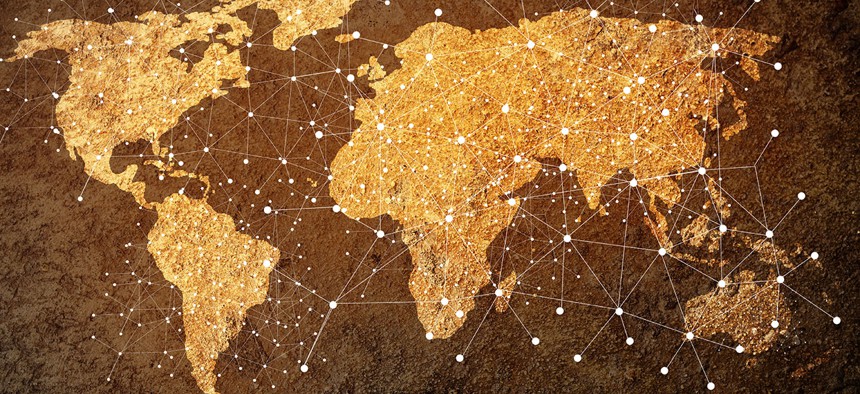
tonefotografia/Shutterstock.com
Map: The State of Global Diplomacy
Visualizing the nearly 6,000 diplomatic ties between 42 countries and 660 cities.
In a society driven by globalization, the world has become increasingly interconnected. Ties among nations and cities have strengthened as leaders band together to come up with solutions to some of the world’s most pressing issues, like terrorism, the Zika outbreak, and climate change. Diplomacy itself now comes in many forms—there’s koala diplomacy , soccer diplomacy , and the emerging field of gastrodiplomacy , to name just a few—that fall outside traditional embassies and ambassadors.
To show just how connected the world is, researchers at the Lowy Institute for International Policy in Australia have created an incredibly detailed interactive that painstakingly maps nearly 6,000 diplomatic ties across 42 countries—members of the Group of 20 ( G20 ) and the Organization for Economic Cooperation and Development ( OECD )—and 660 cities. The first-ever Global Diplomacy Index highlights each country’s global reach by plotting the cities in which it has has embassies, consulates, multilateral missions and “other” representations. Each country is also ranked by the size of its diplomatic network, and not surprisingly, the U.S.—with posts in 270 cities—is No. 1. France, with 267 posts, and China, with 257, follow closely behind. Russia and the U.K. rank fourth and fifth, respectively.
While the top five countries have some of the highest GDPs and are among the most populated nations, the index also reveals that smaller, mostly European, countries have also invested greatly in expanding their diplomatic network. The researchers note , for example, that despite having smaller economies and populations, Switzerland, the Netherlands, and Greece all have more diplomatic posts than Australia.
Six thousand diplomatic ties across 42 countries may seem like a lot, but the researchers also point out that more than half of the developed nations in the OECD have reduced their “diplomatic footprints” over the past decade. For Alex Oliver , the Lowy Institute’s polling director and the project’s lead researcher, it’s a sign that embassies and formal ambassadors may be irrelevant—an opinion that’s been echoed by experts in the past.
thousand diplomatic ties across 42 countries may seem like a lot, but the researchers also point out that more than half of the developed nations in the OECD have reduced their “diplomatic footprints” over the past decade. For Alex Oliver , the Lowy Institute’s polling director and the project’s lead researcher, it’s a sign that embassies and formal ambassadors may be irrelevant—an opinion that’s been echoed by experts in the past.
For many countries, reductions in formal diplomatic posts are a result of budget constraints. But that may prove to be a blessing in disguise, Oliver writes in a recent piece in Foreign Affairs magazine. In the U.K., for example, the Foreign and Commonwealth Office had $143 million cut from its annual budget and laid off 10 percent of its staff. “But the agency’s leaner profile has required it to prioritize and shift resources from its largest European posts, as well as dwindling priorities in Afghanistan and Iraq, to address new crises in Ukraine and West Africa,” she writes.
Oliver argues that, with the rise of both digital communication and security threats, embassies and diplomats are more like “expensive luxuries” than “political assets.” For developing countries battling poverty and poor economies, it’s an enormous cost. Not only are diplomats costly to employ, she says, they lack diversity and are slow to embrace social media and other digital innovation:
The digitally connected world allows governments to communicate directly with their counterparts, and some world leaders, including Indian Prime Minister Narendra Modi, have become prodigious users of Twitter, Facebook, and Instagram, speaking to huge domestic and foreign audiences without even telling their embassies.
But Oliver admits that foreign outposts aren’t completely obsolete. Embassies serve as physical space, and diplomats on the ground can strengthen ties by navigating complex power dynamics and fostering personal relationships. As The Diplomat magazine reported in 2013, “Especially in countries whose cultures put a premium on personal relationships as part of doing business, a lot more is usually achieved over a round of golf, karaoke sessions, or coffee at a cafe compared to constant exchanges of emails or phone calls.”
Still, Oliver argues that, in order for embassies to hold the kind of influence they once did, they will need to adapt. They need to embrace social media and emerging technology to ease security concerns. They need to play a larger role in helping governments better understand their home nations by providing expert analysis to trending news. And even now, the old-school human touch has its benefits: They need to interact more with locals on the ground.
NEXT STORY: Military Retirement Update: Welcome to the TSP!






